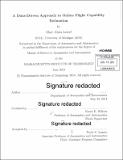| dc.contributor.advisor | Karen E. Willcox. | en_US |
| dc.contributor.author | Lecerf, Marc Alain | en_US |
| dc.contributor.other | Massachusetts Institute of Technology. Department of Aeronautics and Astronautics. | en_US |
| dc.date.accessioned | 2014-10-08T15:22:01Z | |
| dc.date.available | 2014-10-08T15:22:01Z | |
| dc.date.copyright | 2014 | en_US |
| dc.date.issued | 2014 | en_US |
| dc.identifier.uri | http://hdl.handle.net/1721.1/90675 | |
| dc.description | Thesis: S.M., Massachusetts Institute of Technology, Department of Aeronautics and Astronautics, 2014. | en_US |
| dc.description | Cataloged from PDF version of thesis. | en_US |
| dc.description | Includes bibliographical references (pages 89-92). | en_US |
| dc.description.abstract | Similar to a living organism, an autonomous vehicle benefits not only from awareness of its surrounding environment and mission directives, but also from awareness of its performance capability. Because this degrades over time due to fatigue and acute damage, onboard logic often uses conservative estimates of performance from the initial vehicle design to plan feasible mission trajectories. We develop an approach for dynamically estimating vehicle capability to enable safer and more efficient mission planning. The approach leverages multi-level vehicle models in an offline phase to construct a library of information capturing the vehicle behavior in damage scenarios; the behavior is discovered via data-driven classification techniques. After construction, the behavioral library is stored for future queries online by an agent making time-constrained decisions. The research directly links onboard vehicle sensor measurements with an estimate of the current vehicle maneuvering capability using the stored behavioral library. The end-to-end process is implemented and demonstrated in an example flight scenario where an aircraft sustains structural damage to its wing. Safety is assessed based on composite material failure allowables, representing damage to the wing via a local loss of material stiffness. Damage scenarios on the wing are simulated and stored for query during the flight scenario, where knowledge of the maximum maneuvering load factor is estimated using structural strain sensor measurements. Results indicate both an increase in probability of success as well as an increase in overall usage of the vehicle capability, compared to the baseline case that does not dynamically update the capability with onboard sensor information. | en_US |
| dc.description.statementofresponsibility | by Marc Alain Lecerf. | en_US |
| dc.format.extent | 92 pages | en_US |
| dc.language.iso | eng | en_US |
| dc.publisher | Massachusetts Institute of Technology | en_US |
| dc.rights | M.I.T. theses are protected by copyright. They may be viewed from this source for any purpose, but reproduction or distribution in any format is prohibited without written permission. See provided URL for inquiries about permission. | en_US |
| dc.rights.uri | http://dspace.mit.edu/handle/1721.1/7582 | en_US |
| dc.subject | Aeronautics and Astronautics. | en_US |
| dc.title | A data-driven approach to online flight capability estimation | en_US |
| dc.type | Thesis | en_US |
| dc.description.degree | S.M. | en_US |
| dc.contributor.department | Massachusetts Institute of Technology. Department of Aeronautics and Astronautics | |
| dc.identifier.oclc | 890464884 | en_US |
